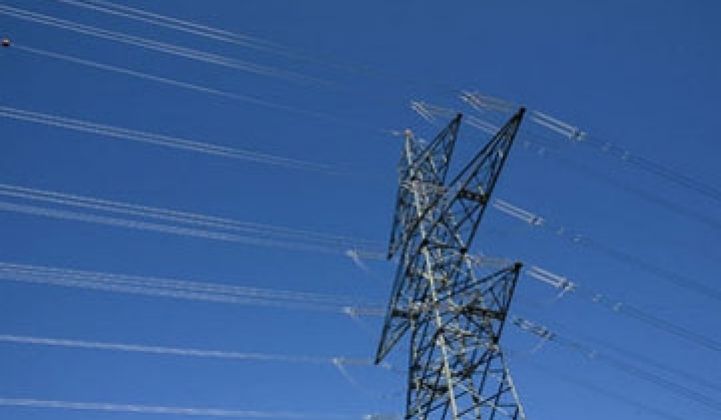The deadline is fast approaching to ask for a piece of the Department of Energy's $3.4 billion Smart Grid Investment Grant Program, and utilities are taking notice.
Four more utilities – CenterPoint Energy, United Illuminating Co., Westar Energy and PPL Electric Utilities – have publicly announced their requests, in advance of the Aug. 6 deadline for applying for the investment grants (see DOE Issues Rules for $3.9B in Smart Grid Stimulus Grants).
Those make up the larger portion of a total of $3.9 billion in stimulus grants for smart grid projects. The remaining portion is for smaller projects that demonstrate new technologies (see DOE Hands Out $47M for Smart Grid Demos).
But for the investment grant program, job creation will be one of the key measures DOE will use to judge winners and losers, industry watchers say – and for many of the utilities that have applied so far, that means big smart meter deployments.
That includes a $317 million request from Texas utility Oncor, a $200 million request from Baltimore Gas & Electric and a $254 million request from Maryland-based Pepco Holdings (see Oncor Makes $317M Smart Grid Pitch and news reports here).
Still, not all the applications are aimed at boosting the number of two-way communicating electric meters in the field (see 8.3M Smart Meters and Counting in U.S.).
Distribution automation projects – sensors, communications and control systems to improve the efficiency of distribution grids – are also seeking a smaller, but significant, portion of the funds available (see Distribution Automation: Smart Grid's Quiet Efficiency Offering).
Take the example of Houston-based CenterPoint Energy, which said Wednesday it would request $200 million from the program.
About $150 million would be aimed at accelerating its deployment of smart meters, it said. CenterPoint expects to have two million of the meters, built by Itron, installed by the end of the project – which could be by 2012 with federal support, or 2014 without it, the utility noted in its press release.
The remaining $50 million would go for CenterPoint's Intelligent Grid project - a distribution automation system that uses smart meters, along with other devices, to maximize efficiency and minimize breakdowns on the portion of the grid that carries power from substations to end users (see GE Offers WiMax Smart Meter Solution).
Another utility seeking funds for distribution grid systems is PPL Electric Utilities in Harrisburg, Pa., which is seeking $19 million in grants to support a proposed $38 million project with key goals of optimizing voltage levels and detecting and isolating problems that can cause outages. General Electric, Lockheed Martin and Alcatel-Lucent would be partners in the project, the utility announced.
On the customer-facing front, New Haven, Ct.-based utility United Illuminating Co. said it would seek $37.5 million in grants to support a $75 million project focused on installing smart meters and the two-way communications systems to support them.
And Kansas-based Westar Energy is seeking up to $20 million to cover half of a $40 million project to install programmable thermostats and Web connections in customers' homes in Lawrence, Kan. The utility is seeking regulator approval for the project, it said.
New York-based Consolidated Edison Co. and Chicago-based Commonwealth Edison are also asking for grants, with ComEd asking for $175 million for a 141,000 smart meter deployment and ConEdison asking an unspecified amount in support of $375 million in planned smart grid projects (see Green Light post).
Also, Spokane, Wash.-based utility Avista said it would seek $20 million to help pay for a distribution grid upgrade, and Arizona utility Salt River Project is seeking an undisclosed amount to support smart meter deployment, as well as substation communications and transmission line monitoring systems.
Then there's Florida Power & Light, which said in April that it would seek stimulus funding for a $200 million project to install about one million smart meters in Miami as part of a larger smart meter project. The utility hasn't publicly specified how much grant funding it would be seeking (see A Million Smart Meters For Miami).
Adding up only the grant applications that have been made public with specific dollar figures attached yields a total of about $1.24 billion in requests so far.
If one assumes that Florida Power & Light and Consolidated Edison would seek up to 50 percent of the costs of the projects for which they've said they'll seek grants, that total would rise to $1.53 billion.
But it's almost certain that many, if not most, of the larger utilities in the country are also seeking smart grid stimulus grants, even if they haven't publicly said so, noted Sandy Goodwin, director of intelligent grid service at E-Source, an energy research firm that serves utility clients.
"Some I think we won't hear about until after the due date," she said. "From what I've heard, DOE is expecting hundreds, if not thousands, of applications."
For example, California's three major investor-owned utilities - Pacific Gas & Electric, Southern California Edison, and San Diego Gas & Electric - had yet to publicize whether or not they were seeking stimulus grants as of Wednesday morning, she noted.
But the three are among the leaders in smart meter deployments, which would seem to make them natural candidates for stimulus, she said.
Beyond the focus on job creation, DOE is likely to favor applications that include plans to provide two-way communications to consumers' homes to send pricing signals or commands that can turn down power-using systems such as air conditioners, water heaters and appliances, Goodwin said.
Such "home area networks" are part of the business plan of most of the smart meter deployments being done in the country today, though real-world efforts remain at the pilot project stage (see Comverge's Home Demand Response: Pagers First, Then Smart Meters and The Smart Home, Part I).



